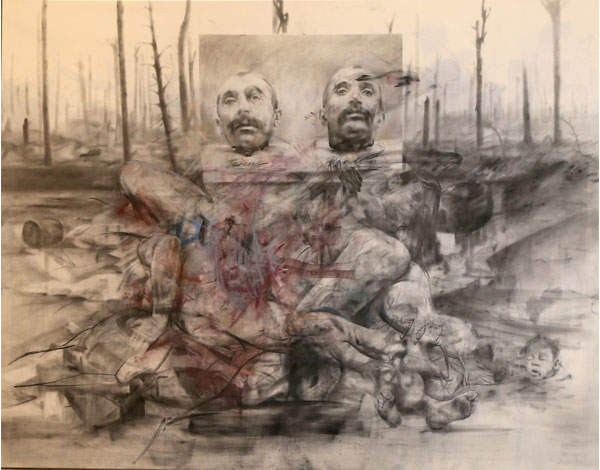

Legacy is too often a dictator. The RA’s latest exhibition, ‘Rubens and His Legacy: Van Dyck to Cezanne’, is thankfully free from such totalising despite the reputation and the temptations of hindsight. This is not an exhibition solely about Rubens: it is an insightful look at the power of interpretation through the works of a great artist and those who came after.
It’s a sturdy pedestal, Rubens’ reputation, transcending nations and cultures as well as generations. The exhibition moves from Van Dyck to Delacroix via Gainsborough to reach Klimt and Picasso’s interpretations, complemented by an additional exhibition refreshingly curated by artist Jenny Saville. It is as much history through art as art history; such a tapestry of artists gives the exhibition undeniable gravity.
However, rather than the responding pictures forming around a single nucleus of genius, his reputation sits across the displays as a running narrative, re-crafted and rewritten by Rubens’ followers, keeping the inspirations fresh and fluid and avoiding stale retrospective deference.
This is brought home from the start where Rubens’ masterful Flemish Landscape with a Rainbow (c1630) sits inside Constable and Turner’s respective takes on their own idealised English landscapes. Their brushstrokes are riotous by comparison but reach out to Rubens’ depictions of the slow, timeless, rural labour also shown in The Carters (c1629).
There is contrast directly where they are similar: Rubens’ intricately blue remembered hills painted for Flemish aristocrats are remoulded by his English disciples with 19th century context; the noble peasant outside the palace becoming the labourer working the idealised rural tracts of a vanishing England.
That sense of nostalgia is tangible. Rubens didn’t invent it but he probably painted it better than anyone else. The astounding quality of his sketches for The Garden of Love (c1610) show his talent that, when rendered in paint on canvas, is so alluringly bright and theatrical in its neoclassical setting that it seems almost kitsch to the modern audience were it not so genuinely beautiful. Rubens’ contemporaries and imitators only emphasise his ability; their facsimiles are obvious, fittingly given the religious subtext, almost conscious in their submission to a greater artistic power.
The neoclassical scenes continue as Rubens, now given mandate as a diplomat, tours post-Reformation European states seeking royal legitimacy in ethereal, cherub-wreathed skies, so bombastic you forget, or buy into, the propaganda, half expecting hautboys and bugles. There is a pronounced world view in these rolling images of gods and kings, framed with the authority of antiquity – our own interpretation of 17th century Europe owes everything to Rubens’ interpretation of ancient Rome.
But Rubens’ baroque walled garden is no prison. The exhibition smoothly transcends any boxes, mixing the likes of Élisabeth Vigée Le Brun with a Qing Dynasty porcelain, emphasising the ranges of Rubens legacy both stylistically and geographically.
The European genes remain, though, not in paint but in the orientalised sex and violence. Rubens, and sequentially Delacroix’s, hunting scenes are the misremembered pasts of legend, flush with action, power and drama – the melees of men fighting menageries of lions, leopards and tigers suggest a biblical war between man and beast.
The holy trinity of art: sex, death and violence are amply catered for. Pain and damnation in Boeckhorst, Makart and Corinth’s interpretations offset Rubens’ own visions of hell. Largely, though, the rolling, voluptuous nudes belong to Rubens. Pan & Syrinx (pictured) is an astounding painting, seminal in the baroque’s own lust for rounded physiques. It is echoed and mirrored by both Cezanne and Picasso in a room that understates: ‘Rubens enjoyed painting buxom nudes.’
However there is a stalling. Rubens was prolific and had range as a painter at the centre of things and this presents a danger in his vision becoming a standard: something proved, if not recognised, by this exhibition. Halfway through you wonder whether we should hate him for making it all seem so second-hand to us now. But this exhibition triumphs in creating a dialogue from the narrative – letting the artists react and not just reflect.
Towards the end Jenny Saville has curated a separate space for her choice of interpretations of Rubens. It gives a direct response, wholly contemporary and free to critique any over-fetishising. It is a brilliant display featuring the nudes of Bacon and Freud, and departing from Rubens’ political magnanimity with Picasso’s The Dream and Lie of Franco. It also gives new meaning to image and propaganda thanks to de Kooning, Warhol and Saville herself.

Voice of the Shuttle (Philomela) by Jenny Saville © Photo by Chris Jackson Getty Images for Royal Academy of Arts
This interested and welcome voice makes this exhibition memorable for all the right reasons (although the labelling is bad) – untrammelling Rubens, putting his art beyond his name and placing his influence in context with his successors, as a sunbeam, not a puppet string.
You can be forgiven for thinking Rubens made it easy for them. There can be few greater attributes but the RA have not built a monolith to Rubens from consensus on his ability, they have refracted his vision through a legion of artist’s prisms. With this exhibition they have provided a meaningful vehicle to view Rubens’ legacy and, crucially, a way to interpret the importance of legacy, and ultimately inspiration, in art.
Rubens and his legacy, Van Dyck to Cezanne is on at the Royal Academy until 10 April 2015






